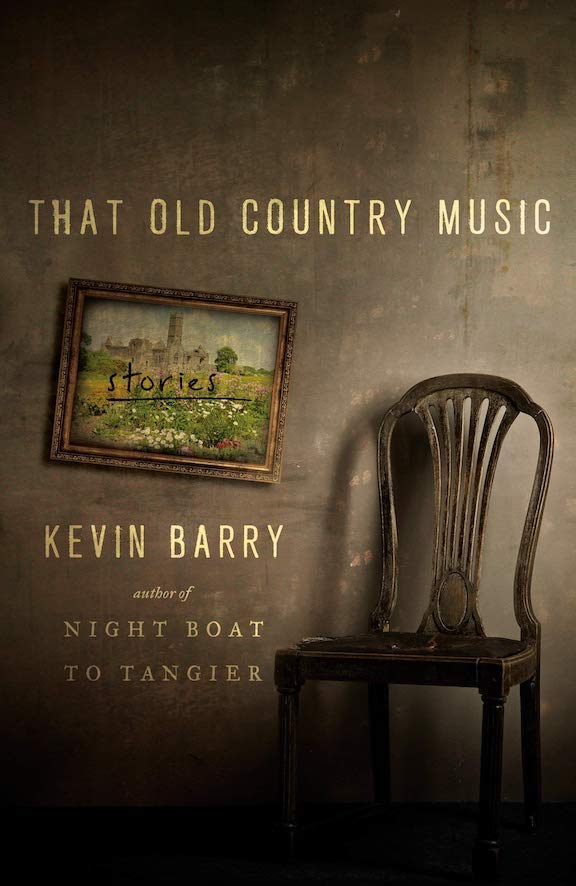Note: Kevin Barry has been WINNER of the IMPAC Dublin Award, the literary world’s biggest prize, WINNER of the Rooney Prize for Irish Literature, and WINNER of the Goldsmith’s Prize, among other prizes.
“I think that the romantic impulse is in all of us and that sometimes we live it for a short time, but it’s not part of a sensible way of living. It’s a heroic path and it generally ends dangerously. I treasure it in the sense that I believe it’s a path of great courage. It can also be the path of the foolhardy and the compulsive.” —Jane Campion, in the Epigraph of this collection by Kevin Barry
 I have enjoyed several of Kevin Barry’s novels, along with Dark Lies the Island, an earlier collection of his short stories. Nothing I have read in the past, however, compares to the dark thrills and surprises packed into this latest collection of stories. Jane Campion’s epigraph, introducing both the book and this review, sums up much of what the reader will find here. Stating her ideas about the romantic impulse in plain and simple language, she regards the pursuit of romance as a heroic path, but warns of its dangers, believing it to be “a path of great courage” for those who pursue it. Sadly, she also believes it to be “foolhardy and compulsive,” a conclusion the reader will observe in many, if not most of the stories here – stories with characters that the reader cannot help but care about while also being aware of their weaknesses, the turmoil in their lives, and the emotional complications they create for those involved with them romantically. This epigraph is also an example of the ultimate irony which lies in wait for those readers who become involved with this collection – a description of romance and a warning presented in the simplest and plainest of language about a group of stories which are, themselves, complex, lyrical, gorgeously descriptive, emotional, most often dark, but filled with ironic humor. These stories raise the reader’s hopes at the same time that they suggest, if not illustrate, that love is nearly always “shy of a happy outcome.”
I have enjoyed several of Kevin Barry’s novels, along with Dark Lies the Island, an earlier collection of his short stories. Nothing I have read in the past, however, compares to the dark thrills and surprises packed into this latest collection of stories. Jane Campion’s epigraph, introducing both the book and this review, sums up much of what the reader will find here. Stating her ideas about the romantic impulse in plain and simple language, she regards the pursuit of romance as a heroic path, but warns of its dangers, believing it to be “a path of great courage” for those who pursue it. Sadly, she also believes it to be “foolhardy and compulsive,” a conclusion the reader will observe in many, if not most of the stories here – stories with characters that the reader cannot help but care about while also being aware of their weaknesses, the turmoil in their lives, and the emotional complications they create for those involved with them romantically. This epigraph is also an example of the ultimate irony which lies in wait for those readers who become involved with this collection – a description of romance and a warning presented in the simplest and plainest of language about a group of stories which are, themselves, complex, lyrical, gorgeously descriptive, emotional, most often dark, but filled with ironic humor. These stories raise the reader’s hopes at the same time that they suggest, if not illustrate, that love is nearly always “shy of a happy outcome.”
The west of Ireland, described by the locals themselves as a “cause of death” in and of itself, is the setting for the stories here, all concerned with themes including love, identity, insecurity, and sometimes resignation. Both heartfelt and ironic, even comic, at times, Barry’s stories create a lively picture of the characters even when those characters are sometimes broken by their own uncertainties. Though some find a measure of happiness, even temporarily, most never find the “ever after,” at least not without recognizing the need for change. ” The lead story, “The Coast of Leitrim,” introduces thirty-five-year-old Seamus Ferris, who believes that he has fallen in love with Katherine, a Polish girl who works in a nearby café with no intention of ever returning to Poland. Seamus has spoken to her just a handful of times, and though he imagines himself as confident, blithe, warm, generous, and suave, the reader quickly deduces that he possesses these qualities only in his imagination.
Slowly, he makes her acquaintance and before long he begins to believe that he is in love with her, but a crisis occurs when they are in bed one night and she begins to talk in her sleep in Polish. Compulsive as he is, he records what she says and has it translated, learns that she loves him, and believes that she will die if he ever leaves her. “He could handle just about anything, he felt, shy of a happy outcome,” and he worries about “what kind of maniac could fall for the likes of me.” His self-consciousness, at the cost of his lover, leads to a dramatic conclusion – two of them, in fact.

The Caves of Keath, an area in which a police sergeant searches for an irresponsible and abusive young man in “Ox Mountain Death Song.”
Other stories deal with death and disappearance, often connected to a love interest. In “Deer Season,” a young girl wants to experience sex before she turns eighteen, chooses a strange man who lives in isolation to be her one-time lover, then spends months wondering about him and the whole “unfathomable business” of sex. In “Ox Mountain Death Song,” a police sergeant nearing retirement has been keeping an eye on on a young man who has been “planting babies all over Ox Mountain” since he was seventeen, often leaving the women abused. The sergeant decides to take action after learning where he is. In “Old Stock,” a man inherits a cottage in the Bluestack Mountains from his uncle and decides to use it while he finishes writing a book, only to discover that the life he leads in the cottage is inconsistent with who he really is. “Toronto and the State of Grace” features a man and his mother, an actress, who arrive at a nearly empty bar and drink all manner of alcohol, getting progressively drunk as they recall the man’s father – until fate steps in. In the title story, “That Old Country Music,” a seventeen-year-old girl, pregnant, waits in a van for her much older lover, a man who had once been her mother’s fiancé. His most recent ambition has been to rob a petrol station with a claw hammer, then drive to the ferry for Scotland. Her wait seems interminable, her memories and her imagination filling her with a combination of both dread and anger as she thinks about the future.
Consummately romantic in style and description, these stories represent a dark kind of romance, not the frothy and prettified style which so often characterizes romantic writing. The characters are damaged and usually ignorant of who they really are and how their actions affect other people. The men are usually insensitive to the fact that women have hopes, dreams, and needs, even as the women are unsure of who and what they themselves are and what they need for a happy life. Loneliness, loss of love, moving on, and the lack of a real sense of home are commonplace in their lives. As Hannah Cryan, the seventeen-year-old featured in the title story, says as she awaits her lover, “The strongest impulse she had was not towards love but towards that burning loneliness, and she knew by nature the tune’s circle and turn – it’s the way the wound wants the knife wants the wound wants the knife.”
ALSO by Barry: BEATLEBONE, CITY OF BOHANE, DARK LIES THE ISLAND, NIGHT BOAT TO TANGIER
Photos: The author’s photo appears on https://www.irishtimes.com
Drormore Hill is where Seamus Ferris and Katherine met for the first time in “The Coast of Leitrim”. https://roaringwaterjournal.com
A police sergeant learns that Canavan is spending his time on Keash Hill in “Ox Mountain Death Song.” https://www.facebook.com/cavesofkeash/
Whitethorn blossoms appear several times in these stories, considered a harbinger of certain death. https://www.alamy.com



